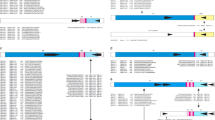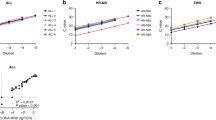Abstract
It is now widely accepted that the detection of minimal residual disease (MRD) has prognostic value in acute leukemia. However clinical MRD studies need standardized techniques. Therefore, several European laboratories have aligned their goals and performed comparative studies to achieve optimization and standardization of MRD techniques. This was achieved via the BIOMED-1 Concerted Action “Investigation of minimal residual disease in acute leukemia: International standardization and clinical evaluation.” This report describes the development of PCR primers and protocols for the detection of MRD in acute lymphoblastic leukemia (ALL) using clone-specific junctional regions of immunoglobulin and T cell receptor gene rearrangements and TAL1 deletions as PCR targets. A total of 54 primers was developed (1) to amplify rearrangements of the TCRD, TCRG, and IGK (Kde) genes as well as TAL1 deletions; (2) to sequence the junctional regions and breakpoint fusion regions; and (3) to perform MRD detection in bone marrow or peripheral blood samples during follow-up of ALL patients. Protocols were established to identify PCR targets at diagnosis by performing 25 PCR reactions per patient using appropriate positive and negative controls. Standardized protocols were developed for MRD monitoring via single amplification of the PCR target followed by dot blot hybridization with the corresponding patient-specific junctional region probe. In addition, alternative approaches were designed for cases where the target sensitivity of at least 10−4 was not obtained. The standardization described here of MRD-PCR techniques is essential for the process of translating MRD research into clinical practice.
This is a preview of subscription content, access via your institution
Access options
Subscribe to this journal
Receive 12 print issues and online access
$259.00 per year
only $21.58 per issue
Buy this article
- Purchase on Springer Link
- Instant access to full article PDF
Prices may be subject to local taxes which are calculated during checkout
Similar content being viewed by others
Author information
Authors and Affiliations
Rights and permissions
About this article
Cite this article
Pongers-Willemse, M., Seriu, T., Stolz, F. et al. Primers and protocols for standardized detection of minimal residual disease in acute lymphoblastic leukemia using immunoglobulin and T cell receptor gene rearrangements and TAL1 deletions as PCR targets Report of the BIOMED-1 CONCERTED ACTION: Investigation of minimal residual disease in acute leukemia. Leukemia 13, 110–118 (1999). https://doi.org/10.1038/sj.leu.2401245
Received:
Accepted:
Published:
Issue Date:
DOI: https://doi.org/10.1038/sj.leu.2401245
Keywords
This article is cited by
-
Identifying IGH disease clones for MRD monitoring in childhood B-cell acute lymphoblastic leukemia using RNA-Seq
Leukemia (2020)
-
Evaluation of cerebrospinal clonal gene rearrangement in newly diagnosed non-Hodgkin’s lymphoma patients
Annals of Hematology (2019)
-
Standardisation and consensus guidelines for minimal residual disease assessment in Philadelphia-positive acute lymphoblastic leukemia (Ph + ALL) by real-time quantitative reverse transcriptase PCR of e1a2 BCR-ABL1
Leukemia (2019)
-
Standardized next-generation sequencing of immunoglobulin and T-cell receptor gene recombinations for MRD marker identification in acute lymphoblastic leukaemia; a EuroClonality-NGS validation study
Leukemia (2019)
-
Molecular remission at the end of treatment is a necessary goal for a good outcome in ELN favorable-risk acute myeloid leukemia: a real-life analysis on 201 patients by the Rete Ematologica Lombarda network
Annals of Hematology (2018)



